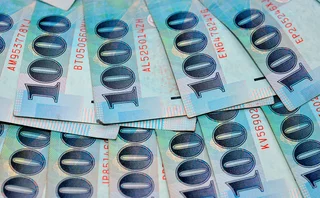
Dollar volatility could be back
The global currency markets could be in for a bout of unseasonal volatility and trading activity if the US dollar breaks through its recent range against the euro, traders said last week, reports RiskNews’ sister publication FX Week .
Bankers said this aggressive pricing action went against a general trend for low volatility. "Option-implied volatility in euro/dollars has fallen dramatically in recent months because the market has not broken out of its range," said Steve Saywell, senior currency strategist at Citigroup.
The decline in implied volatility over recent weeks has also reflected significant demand from the leveraged community for exotic option structures that have positive returns if the ranges are maintained, according to CitiFX research.
Others said July had been one of quietest months for the wholesale market. "Even in the intra-day market, no-one has wanted to buy any gamma," said Kelvin Jouhar, head of foreign exchange at HBOS Treasury Services.
But the dollar’s rise – up 1.1% against the yen on the week and touching ¥112/$ before falling back in trading on Friday – has led traders to ponder whether the move is technical or could be more fundamental in nature.
"This could be the beginning of a big move," said Tony Norfield, global head of forex research at ABN Amro in London. "In euro/dollar, dollar/yen and dollar/sterling, three-month volatility has risen half a point over the past week."
A strengthening dollar is likely to lead to the cutting back of speculative positions – notably short dollar, long euro.
Banks report that in-house research shows that as many as 70–80% of short-term currency funds have lost money this year. "You have a situation where many of these funds are going to jump on what they perceive as a new trend, especially if it’s counter-intuitive – which, until now, a rise in the dollar has been," said Norfield.
All eyes are on data coming out of the US, which is beginning to suggest a strengthening economy and a potential rise in interest rates.
On Tuesday, confidence – measured by the Conference Board index, which measures confidence in the US economy – jumped to 106.1, its highest level for two years, pushing the dollar to a two-month high against the yen and a six-week peak against the euro. The crucial non-farm payroll numbers are due out on Friday, August 6.
If the softness of the US economy looks like being short-lived, accounts are likely to start to reconsider their hedging positions. "At the moment, US interest rates are low so it’s cheap to sell dollars forward," said Norfield. "As US rates rise, selling dollars forward becomes less cheap or even expensive, and we are likely to see a shift in hedging flows in favour of the dollar." Norfield said that if the dollar breaks through its $1.20/e range, it could strengthen as far as $1.15/euro.
The greenback has already broken through its ¥110/$ range, with traders reporting dollar/yen business as the bright spot of a hitherto slow market, with volumes about twice the norm for this time of year.
One brake on the dollar could be the rising oil price, which reached a 21-year high of $43.05 per barrel last week. Higher crude prices could damage the US economy’s recovery, and therefore weaken the dollar, economists said.
Only users who have a paid subscription or are part of a corporate subscription are able to print or copy content.
To access these options, along with all other subscription benefits, please contact info@risk.net or view our subscription options here: http://subscriptions.risk.net/subscribe
You are currently unable to print this content. Please contact info@risk.net to find out more.
You are currently unable to copy this content. Please contact info@risk.net to find out more.
Copyright Infopro Digital Limited. All rights reserved.
As outlined in our terms and conditions, https://www.infopro-digital.com/terms-and-conditions/subscriptions/ (point 2.4), printing is limited to a single copy.
If you would like to purchase additional rights please email info@risk.net
Copyright Infopro Digital Limited. All rights reserved.
You may share this content using our article tools. As outlined in our terms and conditions, https://www.infopro-digital.com/terms-and-conditions/subscriptions/ (clause 2.4), an Authorised User may only make one copy of the materials for their own personal use. You must also comply with the restrictions in clause 2.5.
If you would like to purchase additional rights please email info@risk.net
More on Foreign exchange
Will Taiwan lifers ramp up FX hedging amid tariff turmoil?
As TWD remains strong against the US dollar, Taiwanese life insurers are still poised to act
Deutsche Bank takes AutobahnFX on the open road
Proprietary trading platform sets out new workflow-based approach to collaborating with venues
Dealers bullish on Bloomberg chat interface for FX markets
Service expanded its API offering to integrate broker chats into banks’ engines for cash FX pricing late last year
LCH expects to boost deliverable FX clearing with new adds
Onboarding of dealers and link-up with CLS could swell interbank deliverable FX clearing volumes
Does no-hedge strategy stack up for mag seven mavericks?
At Amazon, Meta and Tesla, the lack of FX hedging might raise eyebrows, but isn’t necessarily a losing technique
Amazon, Meta and Tesla reject FX hedging
Risk.net study shows tech giants don’t hedge day-to-day exposures
Intraday FX swaps could signal new dawn for liquidity management
Seedling market could help banks pre-fund payments in near-real time and reduce HQLA requirements
Natixis turns on the taps in flow trading
French bank boosts flow business, balancing structured solutions capabilities







